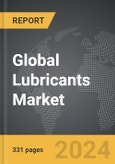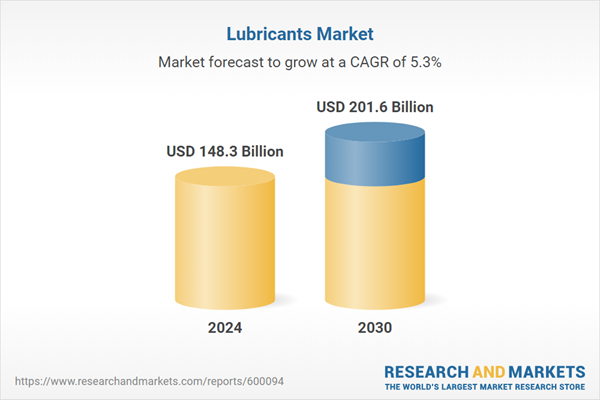Global Lubricants Market - Key Trends & Drivers Summarized
How Is the Lubricants Market Responding to the Surge in Industrial Automation?
The lubricants market is experiencing a significant shift as industries worldwide embrace automation and high-performance machinery. As industrial equipment becomes more sophisticated and operates at higher speeds and temperatures, the demand for specialized lubricants has skyrocketed. Lubricants play a crucial role in reducing friction, minimizing wear and tear, and enhancing the efficiency of automated manufacturing lines, robotics, and CNC machinery. The automotive industry, a key consumer of lubricants, is witnessing a shift toward electric vehicles (EVs), prompting lubricant manufacturers to innovate products that cater to unique EV requirements, such as battery cooling fluids and low-viscosity greases. Simultaneously, industries such as construction, mining, and marine transport are increasingly relying on heavy-duty lubricants to maintain their high-powered equipment. The need for bio-based and environmentally friendly lubricants is also growing, driven by stringent regulations that aim to reduce industrial emissions and environmental impact. As industrial processes become more advanced, the lubricant market is aligning itself with next-generation manufacturing technologies that demand high-performance synthetic and specialty lubricants.What Role Does Technological Innovation Play in Lubricant Development?
Technological advancements are reshaping the lubricants industry, leading to the development of enhanced formulations with improved efficiency and longevity. The shift toward synthetic lubricants, which offer superior thermal stability, oxidation resistance, and extended service life, is a major trend. Nanotechnology is also making its mark, with nanoparticle-based lubricants significantly improving friction reduction and wear resistance in high-performance applications. Smart lubrication systems, integrated with IoT and AI, are enabling real-time monitoring of lubricant performance, allowing industries to optimize lubricant usage and minimize downtime. The development of biodegradable lubricants derived from vegetable oils is gaining traction, catering to industries looking for sustainable alternatives to petroleum-based products. Moreover, manufacturers are investing in hybrid lubricant technologies that combine the best properties of synthetic and mineral-based oils, providing enhanced protection while maintaining cost-effectiveness. These innovations are ensuring that lubricants remain a critical component in high-efficiency industrial operations, adapting to evolving technological landscapes.How Are Regulatory and Environmental Factors Impacting Market Growth?
The lubricants market is facing increasing regulatory scrutiny, with governments and environmental agencies pushing for stricter emission norms and eco-friendly formulations. The European Union and North America have introduced stringent standards limiting the use of certain petroleum-based lubricants due to their environmental impact. As a result, companies are investing in the research and development of biodegradable and non-toxic lubricants that meet compliance standards while maintaining performance. The Asia-Pacific region, a major hub for automotive and industrial production, is seeing a shift toward cleaner lubricant formulations, with China leading the way in regulatory policies promoting green lubricants. Additionally, the increased adoption of energy-efficient machinery is influencing lubricant demand, with high-performance lubricants enabling smoother operations and reduced energy consumption. However, challenges such as fluctuating crude oil prices and supply chain disruptions continue to affect market dynamics, prompting companies to seek alternative raw material sources and localized production strategies.What Are the Key Growth Drivers in the Lubricants Market?
The growth in the lubricants market is driven by several factors, including the expansion of the global automotive industry, increasing industrial automation, and rising demand for high-performance machinery. The rapid electrification of vehicles is reshaping lubricant requirements, with a focus on thermal management fluids and advanced greases. The growing construction and mining sectors are fueling demand for heavy-duty lubricants to maintain equipment efficiency under extreme operating conditions. The push toward sustainable manufacturing is further boosting the adoption of bio-based and low-emission lubricants, especially in regions with stringent environmental policies. Additionally, the rise of smart maintenance solutions, where lubricants are integrated with sensor-based monitoring systems, is transforming the way industries manage equipment lubrication, ensuring predictive maintenance and operational efficiency. With technological advancements and evolving industrial needs, the lubricants market is set for sustained growth, adapting to modern engineering demands.Report Scope
The report analyzes the Lubricants market, presented in terms of market value. The analysis covers the key segments and geographic regions outlined below.- Segments: Application (Industrial, Automotive, Marine, Aerospace).
- Geographic Regions/Countries: World; United States; Canada; Japan; China; Europe (France; Germany; Italy; United Kingdom; Spain; Russia; and Rest of Europe); Asia-Pacific (Australia; India; South Korea; and Rest of Asia-Pacific); Latin America (Argentina; Brazil; Mexico; and Rest of Latin America); Middle East (Iran; Israel; Saudi Arabia; United Arab Emirates; and Rest of Middle East); and Africa.
Key Insights:
- Market Growth: Understand the significant growth trajectory of the Industrial Application segment, which is expected to reach US$53.3 Billion by 2030 with a CAGR of a 4.8%. The Automotive Application segment is also set to grow at 5.6% CAGR over the analysis period.
- Regional Analysis: Gain insights into the U.S. market, valued at $39.1 Billion in 2024, and China, forecasted to grow at an impressive 7.5% CAGR to reach $42.5 Billion by 2030. Discover growth trends in other key regions, including Japan, Canada, Germany, and the Asia-Pacific.
Why You Should Buy This Report:
- Detailed Market Analysis: Access a thorough analysis of the Global Lubricants Market, covering all major geographic regions and market segments.
- Competitive Insights: Get an overview of the competitive landscape, including the market presence of major players across different geographies.
- Future Trends and Drivers: Understand the key trends and drivers shaping the future of the Global Lubricants Market.
- Actionable Insights: Benefit from actionable insights that can help you identify new revenue opportunities and make strategic business decisions.
Key Questions Answered:
- How is the Global Lubricants Market expected to evolve by 2030?
- What are the main drivers and restraints affecting the market?
- Which market segments will grow the most over the forecast period?
- How will market shares for different regions and segments change by 2030?
- Who are the leading players in the market, and what are their prospects?
Report Features:
- Comprehensive Market Data: Independent analysis of annual sales and market forecasts in US$ Million from 2024 to 2030.
- In-Depth Regional Analysis: Detailed insights into key markets, including the U.S., China, Japan, Canada, Europe, Asia-Pacific, Latin America, Middle East, and Africa.
- Company Profiles: Coverage of players such as Amsoil, Inc., Blaser Swisslube India Pvt. Ltd., BP PLC, Buhmwoo Group, Castrol Ltd. and more.
- Complimentary Updates: Receive free report updates for one year to keep you informed of the latest market developments.
Some of the 274 companies featured in this Lubricants market report include:
- Amsoil, Inc.
- Blaser Swisslube India Pvt. Ltd.
- BP PLC
- Buhmwoo Group
- Castrol Ltd.
- Chevron Corporation
- China Petroleum & Chemical Corporation (SINOPEC)
- Exxon Mobil Corporation
- Fuchs Petrolub SE
- Idemitsu Kosan Co., Ltd.
- JXTG Nippon Oil & Energy Corporation
- LUKOIL Lubricants Company
- Pennzoil
- Petrobras
- PetroChina Company Limited
- PetroFer Chemie H. R. Fischer GmbH + Co. KG
- Petronas Lubricants International Sdn Bhd
- Phillips 66 Company
- Quaker Chemical Corporation
- Royal Dutch Shell PLC
- Total SA
- Valvoline, Inc.
- ZELLER+GMELIN GmbH & Co. KG
This edition integrates the latest global trade and economic shifts into comprehensive market analysis. Key updates include:
- Tariff and Trade Impact: Insights into global tariff negotiations across 180+ countries, with analysis of supply chain turbulence, sourcing disruptions, and geographic realignment. Special focus on 2025 as a pivotal year for trade tensions, including updated perspectives on the Trump-era tariffs.
- Adjusted Forecasts and Analytics: Revised global and regional market forecasts through 2030, incorporating tariff effects, economic uncertainty, and structural changes in globalization. Includes historical analysis from 2015 to 2023.
- Strategic Market Dynamics: Evaluation of revised market prospects, regional outlooks, and key economic indicators such as population and urbanization trends.
- Innovation & Technology Trends: Latest developments in product and process innovation, emerging technologies, and key industry drivers shaping the competitive landscape.
- Competitive Intelligence: Updated global market share estimates for 2025, competitive positioning of major players (Strong/Active/Niche/Trivial), and refined focus on leading global brands and core players.
- Expert Insight & Commentary: Strategic analysis from economists, trade experts, and domain specialists to contextualize market shifts and identify emerging opportunities.
Table of Contents
Companies Mentioned (Partial List)
A selection of companies mentioned in this report includes, but is not limited to:
- Amsoil, Inc.
- Blaser Swisslube India Pvt. Ltd.
- BP PLC
- Buhmwoo Group
- Castrol Ltd.
- Chevron Corporation
- China Petroleum & Chemical Corporation (SINOPEC)
- Exxon Mobil Corporation
- Fuchs Petrolub SE
- Idemitsu Kosan Co., Ltd.
- JXTG Nippon Oil & Energy Corporation
- LUKOIL Lubricants Company
- Pennzoil
- Petrobras
- PetroChina Company Limited
- PetroFer Chemie H. R. Fischer GmbH + Co. KG
- Petronas Lubricants International Sdn Bhd
- Phillips 66 Company
- Quaker Chemical Corporation
- Royal Dutch Shell PLC
- Total SA
- Valvoline, Inc.
- ZELLER+GMELIN GmbH & Co. KG
Table Information
| Report Attribute | Details |
|---|---|
| No. of Pages | 418 |
| Published | December 2025 |
| Forecast Period | 2024 - 2030 |
| Estimated Market Value ( USD | $ 148.3 Billion |
| Forecasted Market Value ( USD | $ 201.6 Billion |
| Compound Annual Growth Rate | 5.3% |
| Regions Covered | Global |









